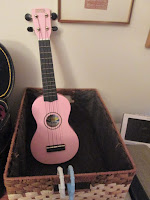The 2023 harvest season isn't quite over yet, but the clock is ticking. According to the weather forecast, the first frost of the year is likely to hit on Wednesday night, so we need to make sure all our tender crops are gathered in by then. That means all the lettuce and arugula (both in the beds and on the paths); all the parsley and basil; all the peppers and tomatoes, both ripe and unripe; all the French beans on their little trellis. We'll also have to pick all the tiny fruits off our new strawberry plants and get them properly bedded down for winter with a layer of leaf mulch. And on top of that, we still need to get next year's garlic crop into the ground.
Unfortunately, we weren't able to get all that done this weekend. Yesterday we had perfect weather for it, sunny and remarkably warm for late October, but we spent the entire day at a Renaissance fair with friends and didn't get home until after dark. Today, by contrast, we were free all day, but the weather was uncooperative: dark, damp, and chilly, with heavy rain for most of the afternoon. Only around dusk did it let up enough for Brian to pop outside and collect a small load of produce: all the beans and lettuce big enough to pick, a handful of arugula, a few Banana peppers, some ripe Sun Gold tomatoes, and a big bunch of rhubarb. But the rest of the gardening chores will have to be squeezed in as best we can over the next two evenings.Once they're done, the garden won't be completely empty. The dozen or so leeks still in the bed can stand to stay put a little longer, as can the butternut squash. Frankly, though, no matter how much longer we leave those on the vine, it won't be enough to give us an impressive harvest. We've already harvested the four squash of decent size that our Waltham plant has produced, and there are only two smaller ones left that might grow ripe enough to harvest before the first hard freeze. As for the new Honeynut squash that we tried this year as an experiment, the two vines we planted have produced exactly one ripe squash between them, probably less than four ounces in weight. Granted, all of that is edible (you don't even have to peel it), but it's still not much to show for the four square feet of our precious garden space we devoted to this crop. Next year we'll most likely drop it and plant two extra Walthams instead.
But even if our squash harvest isn't much to celebrate, we can still take satisfaction in what we have. We'll saute the beans tonight to accompany our mushroom tourtière. We'll combine the lettuce, arugula, and Sun Golds tomorrow in what will probably be our last homegrown salad of the season. We'll use the rhubarb on Wednesday to make chicken in rhubarb sauce for some friends coming to dinner. With each bite, we'll savor the last of summer's bounty, even as we prepare ourselves for the winter to come.









